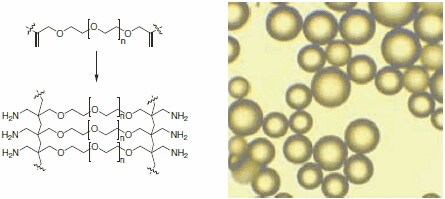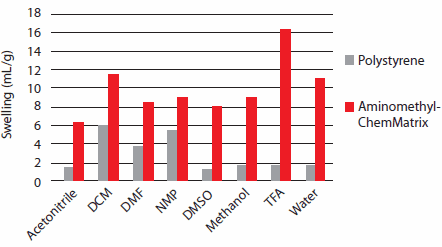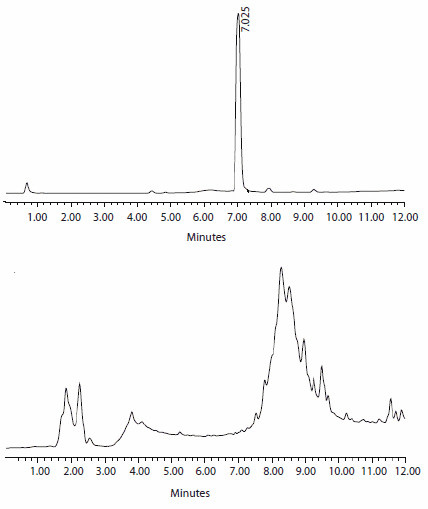ChemMatrix® Resin for Solid Phase Peptide Synthesis
ChemMatrix® is a proprietary, 100% PEG (polyethylene glycol) based resin from PCAS BioMatrix. It combines the strengths of two major resin systems — the chemical stability of polystyrene resins and the superior performance of PEG grafted resins making it the ultimate choice for the solid supported synthesis of large or hydrophobic peptides and even proteins.
In the past decades, polystyrene resins have been the primary choice for solid supported peptide synthesis due to their good results in the synthesis of small peptides. Nevertheless, with the growing amino acid chain during the synthesis, the tendency of the peptide to form secondary structures increases. The hydrophobic environment of the polystyrene resin amplifi es the aggregational behavior of the peptide making the synthesis of large peptides extremely diffi cult or even impossible. Crude products of large peptides synthesized on polystyrene resins exhibit a mixture of deletion sequences and uncompleted fragments. PEG grafted resins have helped to reach better crude peptide purities by making the resin more polar and improving the swelling properties in both polar and unpolar solvents. As a drawback such PEG grafted resins only allow smaller loadings and are less chemically stable leading to potential leaching during the cleavage step.
ChemMatrix® resin was designed from scratch starting with a new type of monomer building block. The fi nal polymer resin is built exclusively on primary ether bonds and therefore exhibits high chemical stability, avoiding leaching (Figure 1).1

Figure 1.The scaff old of Aminomethyl-ChemMatrix® resin is built completely on chemically stable polyether bonds (left). Microscopic image of ChemMatrix® beads (right).
At the same time, the increased polarity of the resin allows the use of various polar solvents, including: water, THF, DMF, methanol and acetonitrile, in which the resin displays excellent swelling properties (Figure 2). High swelling properties should be considered during practical use as the wet ChemMatrix® resin will consume considerably more space in the reaction vessel than conventional polystyrene resins. Typical loading ranges are between 0.4 and 0.7 mmol/g which is a comparable binding capacity as polystyrene resins.

Figure 2.Swelling properties of ChemMatrix® resin compared to polystyrene resin.
Two recent independent publications give remarkable evidence for the unmatched performance of ChemMatrix® resin. For the synthesis of HIV–1 protease, a large peptide of 99 amino acids, ChemMatrix® resin was compared directly to polystyrene.2 As the following chromatograms clearly show, the desired peptide is the main component of the crude product using ChemMatrix® as the solid support (Figure 3). Polystyrene resins only deliver crude mixtures preventing the direct, linear synthesis of long peptides.

Figure 3.HPLC chromatograms of HIV–1 protease (99 amino acids) after 78 amino acids. The synthesis on ChemMatrix® resin yields the desired peptide directly without further purifi cation (top) whereas polystyrene resin only yields a very crude mixture (bottom).
In a second amazing example, Bacsa et al. reported in 2010, the solid supported, microwave assisted synthesis of the polypeptide Aβ(1–42).3 Aβ (1–42) plays a crucial role in the pathogenesis of Alzheimer’s disease in that it forms β–sheet structures and amyloid fi brils which induce neurotoxicity. Thus, it is a key material needed to further investigate the molecular mechanisms of Alzheimer’s disease and potential drugs for its treatment. Due to its aggregational behavior this peptide is highly diffi cult to synthesize. ChemMatrix® resin allows the direct, linear synthesis with a standard Fmoc/t–Bu synthesis strategy applying DIC/HOBt as a simple and inexpensive coupling reagent. Except for the coupling of three racemization sensitive histidine residues which was carried out at room temperature the synthesis was achieved under controlled microwave conditions at 86 °C. ChemMatrix resin remained completely stable under these conditions.4 Finally, Aβ(1–42) was obtained within a 15h overall processing time in high yield and purity (78% crude yield).3
Apart from peptide synthesis ChemMatrix® resin has also been used successfully in combinatorial synthesis,5 for the synthesis of oligonucleotide derivatives,6 PNA,7 asymmetrically substituted phthalocyanines,8 and peptide hybrids incorporating non-natural chemical residues.9
In summary, ChemMatrix® overcomes the challenges of synthesizing longer and more complex therapeutic peptides. Peptides produced with ChemMatrix® have higher purity and can be obtained with better yields. Peptides that were hitherto achievable only by ligation or recombinant techniques can now be synthesized directly on solid support.
For the synthesis of peptide acids, we recommend using the ChemMatrix® with a HMPB anchor as this resin will provide high crude purity and a recovery yield of 90–95%. The Wang-ChemMatrix® will produce similar crude peptide purity, but the recovery yield is lower (60–70%). HMPB–ChemMatrix® resins are also off ered preloaded with the most common amino acids. A number of protocols for the application of ChemMatrix resin have been published recently in the literature.10
Features of ChemMatrix® Resin
- Exceptional Stability
ChemMatrix® resin is made exclusively from primary ether bonds which are highly chemically stable. No leaching occurs during synthesis and cleavage. - High Loading
ChemMatrix® resins have a loading of 0.4–0.7 mmol/g. - Solvent Compatibility
ChemMatrix® allows the use of almost any kind of solvent, even water. High swelling properties of ChemMatrix® in water allows high throughput post-synthetic downstream screening. - Versatile Choices
ChemMatrix® resin is off ered with an extensive range of linkers for peptide acids, amides and fragments. For peptide synthesis, preloaded resins are also available for your convenience. - Demonstrated Superiority
ChemMatrix® resin has been fi eld proven for easier and faster development of long, complex and hydrophobic peptides. The longer, the more complex or hydrophobic your peptide is, the more improvement you will see with ChemMatrix®. - Microwave assisted synthesis
No leaching is observed on microwave synthesizers at 80 °C.
Materials
References
To continue reading please sign in or create an account.
Don't Have An Account?